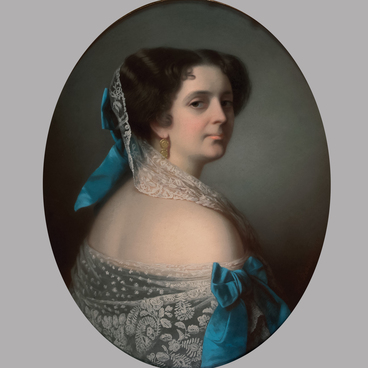The ceremonial portrait of Vice Admiral Pyotr Gavrilovich Kashkin was painted by an unknown artist in the mid-18th century. Pyotr Gavrilovich was born in 1695. He studied at the Moscow School of Mathematics and Navigation. In 1715, he was sent by Peter the Great to the Naval Academy in St. Petersburg, and in 1717, along with other midshipmen, he was sent to Venice to practice. He returned to St. Petersburg in May 1720. After the examination conducted by Peter, he was granted the rank of non-commissioned lieutenant (sub-lieutenant) of the galley fleet.
In 1756, he was appointed director of the Admiralty, in May 1757, he was promoted to Rear Admiral. In 1752–1760, he participated in the Memel expedition, where he built ships for carrying pieces of artillery, and also made maps of the seashore from Konigsberg to Pillau. In 1763, Kashkin was promoted to Vice Admiral. However, he did not stay in his new position for long, as he asked to resign for health reasons. Pyotr Gavrilovich Kashkin died on April 1, 1764.
The portrait was painted in 1763 in St. Petersburg to commemorate the new title of Vice Admiral granted to Pyotr Gavrilovich Kashkin. Pyotr Gavrilovich, who had leg pain after he got wounded, is depicted sitting in an armchair with a cane in his hand. He is dressed in a white vice admiral’s uniform trimmed with gold embroidery, with a ribbon and the Order of St. Anna, 1st class, which was awarded to him in 1762. In the 18th century, strips of gold embroidery indicated differences in military insignia.
In its artistic features, the portrait of Pyotr Gavrilovich retains many archaic attributes characteristic of parsuna, an early genre of portrait: a violation of perspective in the depiction of space, flatness and stiffness of the figure, broadness of the image, careful rendering of facial features and details of the clothes. But the portrait also shows some aspects of secular, court painting: interest in the personality of the sitter and the use of chiaroscuro (contrast between light and dark in the depiction of the face and figure). The manner of painting is distinguished by expressive modeling of forms and a harmonious color palette based on the contracting color accents. Such a combination of parsuna elements with new attributes of secular painting endows the portrait with a special solemnity and monumentality.
In 1756, he was appointed director of the Admiralty, in May 1757, he was promoted to Rear Admiral. In 1752–1760, he participated in the Memel expedition, where he built ships for carrying pieces of artillery, and also made maps of the seashore from Konigsberg to Pillau. In 1763, Kashkin was promoted to Vice Admiral. However, he did not stay in his new position for long, as he asked to resign for health reasons. Pyotr Gavrilovich Kashkin died on April 1, 1764.
The portrait was painted in 1763 in St. Petersburg to commemorate the new title of Vice Admiral granted to Pyotr Gavrilovich Kashkin. Pyotr Gavrilovich, who had leg pain after he got wounded, is depicted sitting in an armchair with a cane in his hand. He is dressed in a white vice admiral’s uniform trimmed with gold embroidery, with a ribbon and the Order of St. Anna, 1st class, which was awarded to him in 1762. In the 18th century, strips of gold embroidery indicated differences in military insignia.
In its artistic features, the portrait of Pyotr Gavrilovich retains many archaic attributes characteristic of parsuna, an early genre of portrait: a violation of perspective in the depiction of space, flatness and stiffness of the figure, broadness of the image, careful rendering of facial features and details of the clothes. But the portrait also shows some aspects of secular, court painting: interest in the personality of the sitter and the use of chiaroscuro (contrast between light and dark in the depiction of the face and figure). The manner of painting is distinguished by expressive modeling of forms and a harmonious color palette based on the contracting color accents. Such a combination of parsuna elements with new attributes of secular painting endows the portrait with a special solemnity and monumentality.



